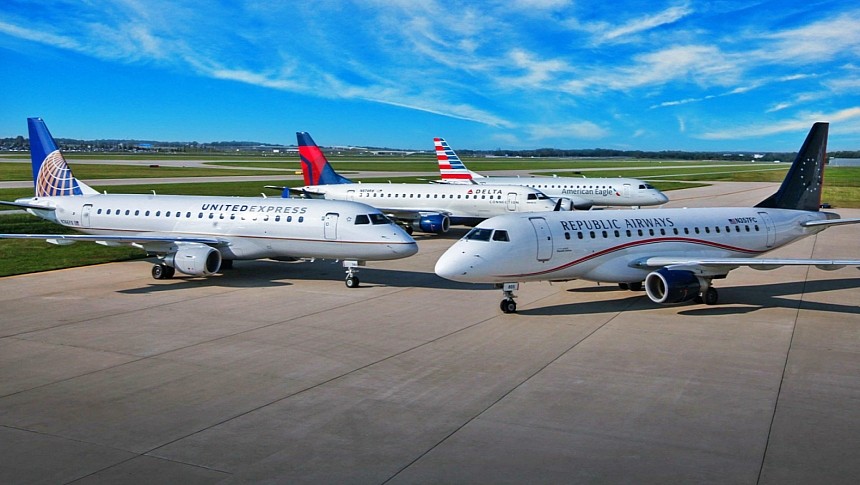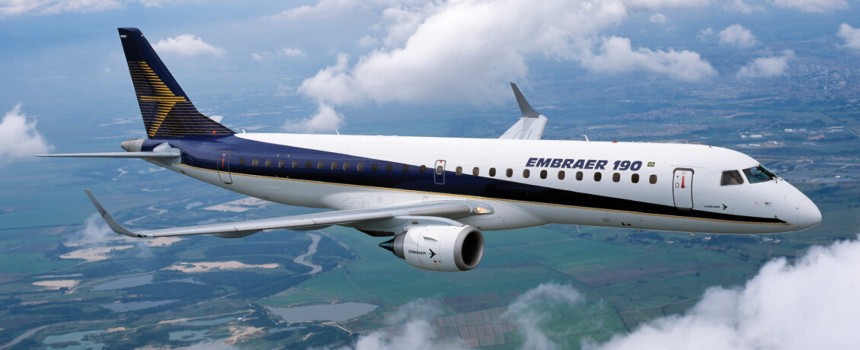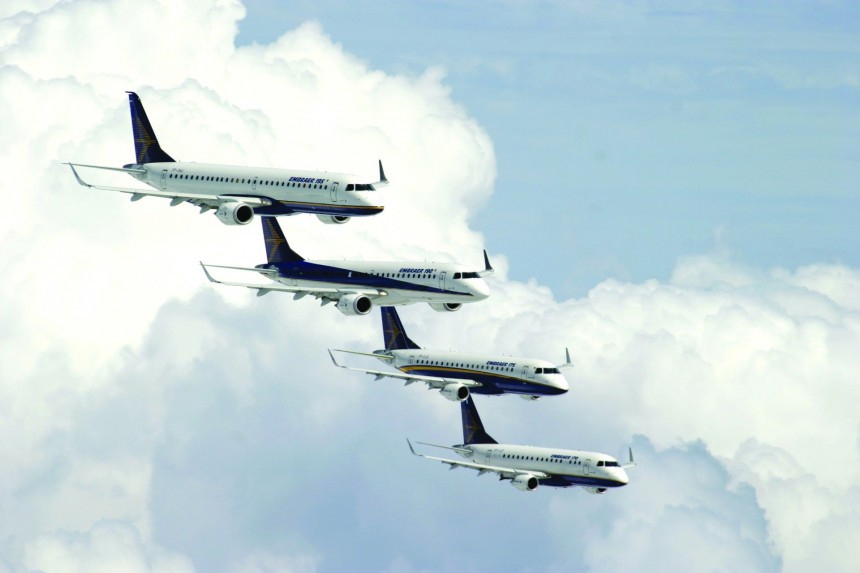If it weren't for a handful of smaller international aviation firms, chances are good the world's civil jetliner sector would be a complete two-horse race between the monolithic titans of Airbus and Boeing. There are a couple of different airliner manufacturers you could point to as the most important protectorates against an ethically dubious duopoly in the civil aviation space. But today, let's put a focusing lens on Embraer in particular. Without their E-Jet family, Embraer may have never arrived hot on the global scene in the way it did.
The story of the Embraer E-Jet family is one of a perpetual underdog. One of Brazilian national pride that'd go on to define South America's largest economy in a way that highlights a remarkably adaptable aviation sector. Indeed, Embraer was a very different company in the days before the ERJ program. Founded out of a desire by the Brazilian military dictatorship then in power, Embraer's genesis in August 1969 was meant to be a profound statement to the US and Western Europe. One decreeing that before long, the global civil airliner space wouldn't be split evenly between two continents in the Northern Hemisphere for much longer.
Embraer's first product, the 18-passenger, twin-engine EMB 110 Bandeirante, set the precedent for what the rest of the company's range of aircraft would one day look like. A platform that lent well to small sizes with minimal passenger capacity but the same respectable flight performance and high standard of build quality that American or European light aircraft took for granted. From the proverbial rib of the Bandeirante spawned the military transport-darling EMB 121 Xingu, using the same wing and engine layout but with a sleeker, more VIP-friendly fuselage.
From there, Embraer built off their first meager successes with their second wholly bespoke airframe, the twin-turboprop, 30-passenger, three-abreast EMB 120 Brasilia. As one of Embraer's first airframes to be sold primarily in the United States and elsewhere outside Brazil, the Brazilia was Embraer's triumphant arrival at airport terminals across the United States, Canada, and Europe. All-time-great aircraft manufacturers like Cessna and Piper built billion-dollar empires selling primarily light aircraft no larger than the EMB 120 Brasilia, but Embraer had much larger ambitions as the 80s gave way to the 90s.
In the same vein as more established regional jets from European firms like Fokker and British Aerospace, the ERJ Family in its 37-passenger 135 forms, 44-passenger ERJ140, and 50-passenger ERJ 145, used the Brasilia's three-abreast seat arrangement and took it up a notch with Rolls-Royce AE 3007 to whisp their passengers along at nearly 80 percent the speed of sound. Through the Embraer Legacy 600 business jet that shares an airframe with the ERJ-145, the top one percent of society could have the same attributes applied to a first-class large business jet.
But puddle-jumper regional jets alone wouldn't put Embraer in the same regard as Airbus or Boeing. Only a fully-fledged narrow-body airliner with the capacity for triple-digit passengers and the range to cross the continental U.S. would make the established civil aviation aristocracy sweat. With three decades of R&D at their backs, Embraer made its first public announcement of a narrow-body, long-range jetliner in March 1997. At first, the concept was intended to accommodate 70 passengers, leading to the development name EMB 170.
When that was deemed insufficient, the project was reworked into a larger, more elongated airframe that was formally announced in February 1999 before its big reveal at the Paris Air Show in June of that year under the name E-Jet. In front of a Parisian crowd so used to runways flanked by endless variations of the Boeing 737, the sight of a scrappy Brazilian newcomer to a sector dominated by two titans was a remarkable spectacle. With its first flight on February 19th, 2002, Embraer was officially a force in the full-size, narrow-body airliner sector.
The first-generation E-Jet family was divided into four variants tailored to different segments of narrow-body jetliner work. The introductory variant, the E170, can accommodate up to 78 passengers if arranged in its high-capacity configuration. With a length of just under 30 meters (98.4 ft) and a wingspan of just over 26 meters (85.3 ft), the E170 and its slightly lengthened E175 counterpart were the most regional-friendly of the E-Jet family. But with the lifting potential of a full-sized airliner owed to two General Electric CF34-8E engines, smaller members of the E-Jet family can haul more cargo than a true-to-form regional jet over similar routes.
With 14,200 lbs (63 kN) of thrust to work with, up to 88 passengers could cruise at 75 percent the speed of sound in the E175, ditto on the speed for the E170. On its deployment in March 2004, the E170 soon found success with smaller airlines unable to afford big Boeing and Airbus jets. Its first launch customer was Poland's flag-carrier airline, LOT Polish Airlines, and the type remained popular with smaller Western airlines like Alitalia, the former largest airline in Italy, and the US Airways subsidiary MidAtlantic Airways. With crisp, responsible fly-by-wire controls on par with anything from Boeing or Airbus, pilots had little to complain about when it came to flying Embraer's first non-regional jetliner.
It was a reputation that followed the E-Jet into its first launch customer for the stretched E175, Air Canada, in 2005. Soon after, lucrative orders from Republic Airways for 62 E170 airframes cemented the type's place in North American skies. A further 193 orders for the E175 by SkyWest Airlines really drove the point home, while the larger, re-engined E190 and E195 were prepped for their operational debuts soon afterward in September 2006. With more powerful 10E variants of the GE CF34 engine jetting 20,000 lbs of thrust each, key factors like time to climb numbers and maximum range were marginally boosted in the E190/195 on top of a bump in passenger capacity from 114 to 124 people depending on the model and seating layout.
With the acquisition of 47 E190s by JetBlue, Embraer aircraft were now in service under the same corporate banner that'd been dominated by Airbus products up to that point. With a form factor that slides so smoothly in between the Boeing 747 and the Airbus A320, the E190 is the goldilocks point that's not too big nor too small for a breadth of large and small airlines. Over 1,700 first-generation E-Jets have been sold, according to data from Ebraer's commercial aviation website. That's without counting sales from the positively "Ridonkulous" E190 business jet conversion, the Lineage 1000, or the E-190F freighter variant.
That's without discussing the original E-Jet's contemporary descendants, the E-Jet E2 family. With new and improved variants of the Pratt & Whitney PW1900G turbofan optimized for each of the three E-Jet E2 jets in service, smaller E175-E2s produce 15,000 lbs (67 kN) of thrust while the larger E190-E2 and E195-E2 can make up to 23,000 lbs (102 kN) on takeoff. It allows the E Jet E2 line to do everything its ancestor jets could do, all while saving fuel and reducing operating costs thanks to an entirely new layer of refinement added to an already flexible and potent airframe.
Today, both the E1 and E2 lines of Embraer E-Jets are still in production in Brazil, with orders for the former still waiting to be filled in accordance with airline contracts. Though JetBlue intends to ditch their E190s by 2025 in favor of newer Airbus A320 derivatives, chances are still good the type will remain a relevant platform in the international airliner sector for at least a few more years to come. In the meantime, it's important to appreciate how Embraer's spent the last 20 years acting as a safeguard against a duopoly in the narrow-body airliner sector that nobody, be it analysts or industry insiders, wants to see come to pass in our lifetimes.
Embraer's first product, the 18-passenger, twin-engine EMB 110 Bandeirante, set the precedent for what the rest of the company's range of aircraft would one day look like. A platform that lent well to small sizes with minimal passenger capacity but the same respectable flight performance and high standard of build quality that American or European light aircraft took for granted. From the proverbial rib of the Bandeirante spawned the military transport-darling EMB 121 Xingu, using the same wing and engine layout but with a sleeker, more VIP-friendly fuselage.
From there, Embraer built off their first meager successes with their second wholly bespoke airframe, the twin-turboprop, 30-passenger, three-abreast EMB 120 Brasilia. As one of Embraer's first airframes to be sold primarily in the United States and elsewhere outside Brazil, the Brazilia was Embraer's triumphant arrival at airport terminals across the United States, Canada, and Europe. All-time-great aircraft manufacturers like Cessna and Piper built billion-dollar empires selling primarily light aircraft no larger than the EMB 120 Brasilia, but Embraer had much larger ambitions as the 80s gave way to the 90s.
In the same vein as more established regional jets from European firms like Fokker and British Aerospace, the ERJ Family in its 37-passenger 135 forms, 44-passenger ERJ140, and 50-passenger ERJ 145, used the Brasilia's three-abreast seat arrangement and took it up a notch with Rolls-Royce AE 3007 to whisp their passengers along at nearly 80 percent the speed of sound. Through the Embraer Legacy 600 business jet that shares an airframe with the ERJ-145, the top one percent of society could have the same attributes applied to a first-class large business jet.
When that was deemed insufficient, the project was reworked into a larger, more elongated airframe that was formally announced in February 1999 before its big reveal at the Paris Air Show in June of that year under the name E-Jet. In front of a Parisian crowd so used to runways flanked by endless variations of the Boeing 737, the sight of a scrappy Brazilian newcomer to a sector dominated by two titans was a remarkable spectacle. With its first flight on February 19th, 2002, Embraer was officially a force in the full-size, narrow-body airliner sector.
The first-generation E-Jet family was divided into four variants tailored to different segments of narrow-body jetliner work. The introductory variant, the E170, can accommodate up to 78 passengers if arranged in its high-capacity configuration. With a length of just under 30 meters (98.4 ft) and a wingspan of just over 26 meters (85.3 ft), the E170 and its slightly lengthened E175 counterpart were the most regional-friendly of the E-Jet family. But with the lifting potential of a full-sized airliner owed to two General Electric CF34-8E engines, smaller members of the E-Jet family can haul more cargo than a true-to-form regional jet over similar routes.
With 14,200 lbs (63 kN) of thrust to work with, up to 88 passengers could cruise at 75 percent the speed of sound in the E175, ditto on the speed for the E170. On its deployment in March 2004, the E170 soon found success with smaller airlines unable to afford big Boeing and Airbus jets. Its first launch customer was Poland's flag-carrier airline, LOT Polish Airlines, and the type remained popular with smaller Western airlines like Alitalia, the former largest airline in Italy, and the US Airways subsidiary MidAtlantic Airways. With crisp, responsible fly-by-wire controls on par with anything from Boeing or Airbus, pilots had little to complain about when it came to flying Embraer's first non-regional jetliner.
With the acquisition of 47 E190s by JetBlue, Embraer aircraft were now in service under the same corporate banner that'd been dominated by Airbus products up to that point. With a form factor that slides so smoothly in between the Boeing 747 and the Airbus A320, the E190 is the goldilocks point that's not too big nor too small for a breadth of large and small airlines. Over 1,700 first-generation E-Jets have been sold, according to data from Ebraer's commercial aviation website. That's without counting sales from the positively "Ridonkulous" E190 business jet conversion, the Lineage 1000, or the E-190F freighter variant.
That's without discussing the original E-Jet's contemporary descendants, the E-Jet E2 family. With new and improved variants of the Pratt & Whitney PW1900G turbofan optimized for each of the three E-Jet E2 jets in service, smaller E175-E2s produce 15,000 lbs (67 kN) of thrust while the larger E190-E2 and E195-E2 can make up to 23,000 lbs (102 kN) on takeoff. It allows the E Jet E2 line to do everything its ancestor jets could do, all while saving fuel and reducing operating costs thanks to an entirely new layer of refinement added to an already flexible and potent airframe.
Today, both the E1 and E2 lines of Embraer E-Jets are still in production in Brazil, with orders for the former still waiting to be filled in accordance with airline contracts. Though JetBlue intends to ditch their E190s by 2025 in favor of newer Airbus A320 derivatives, chances are still good the type will remain a relevant platform in the international airliner sector for at least a few more years to come. In the meantime, it's important to appreciate how Embraer's spent the last 20 years acting as a safeguard against a duopoly in the narrow-body airliner sector that nobody, be it analysts or industry insiders, wants to see come to pass in our lifetimes.
















